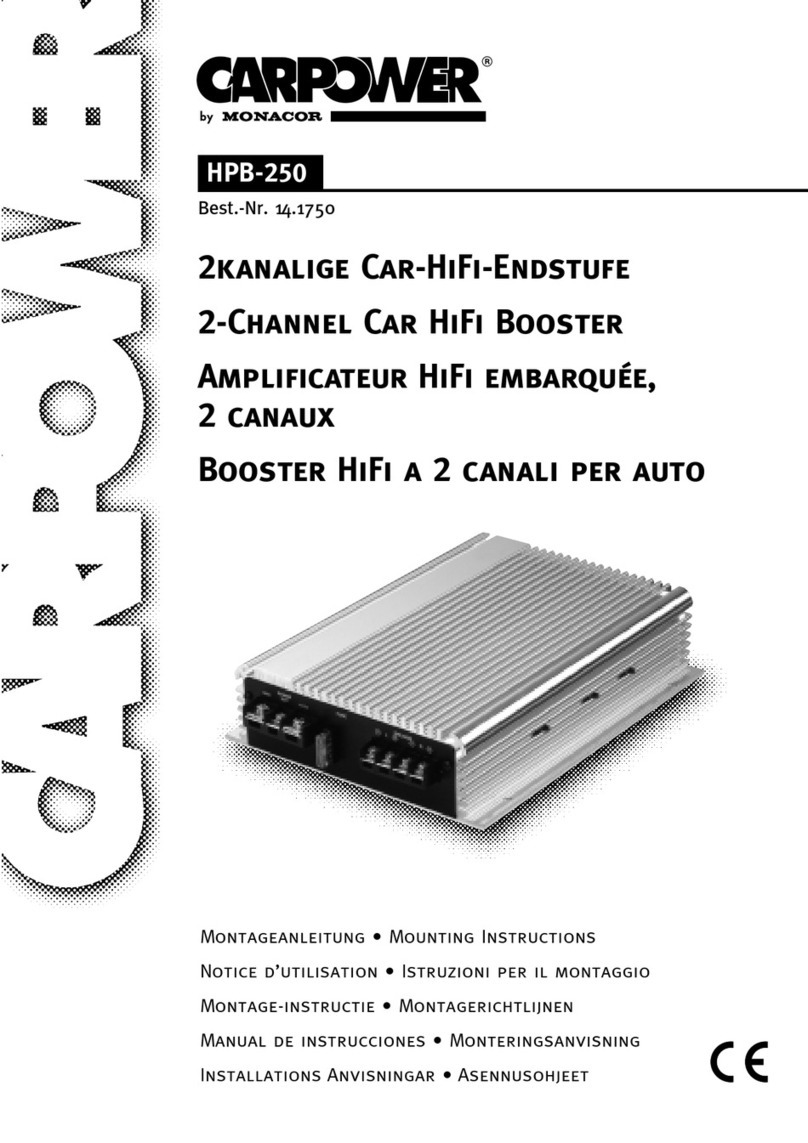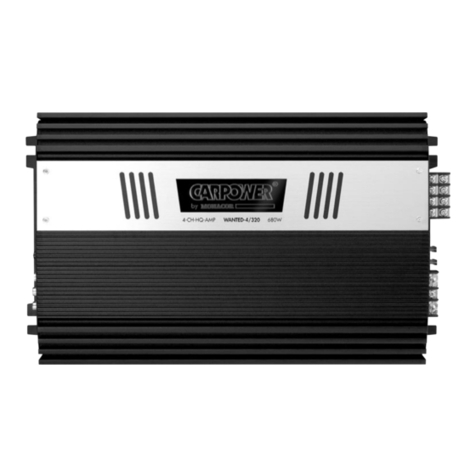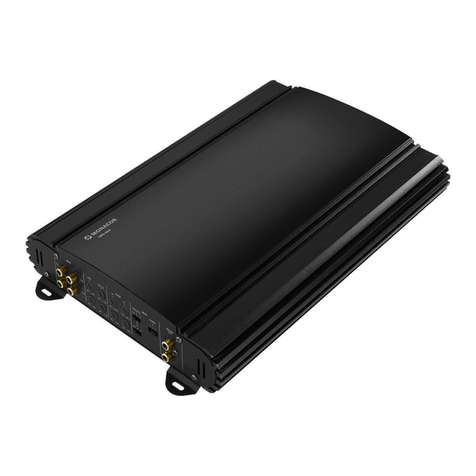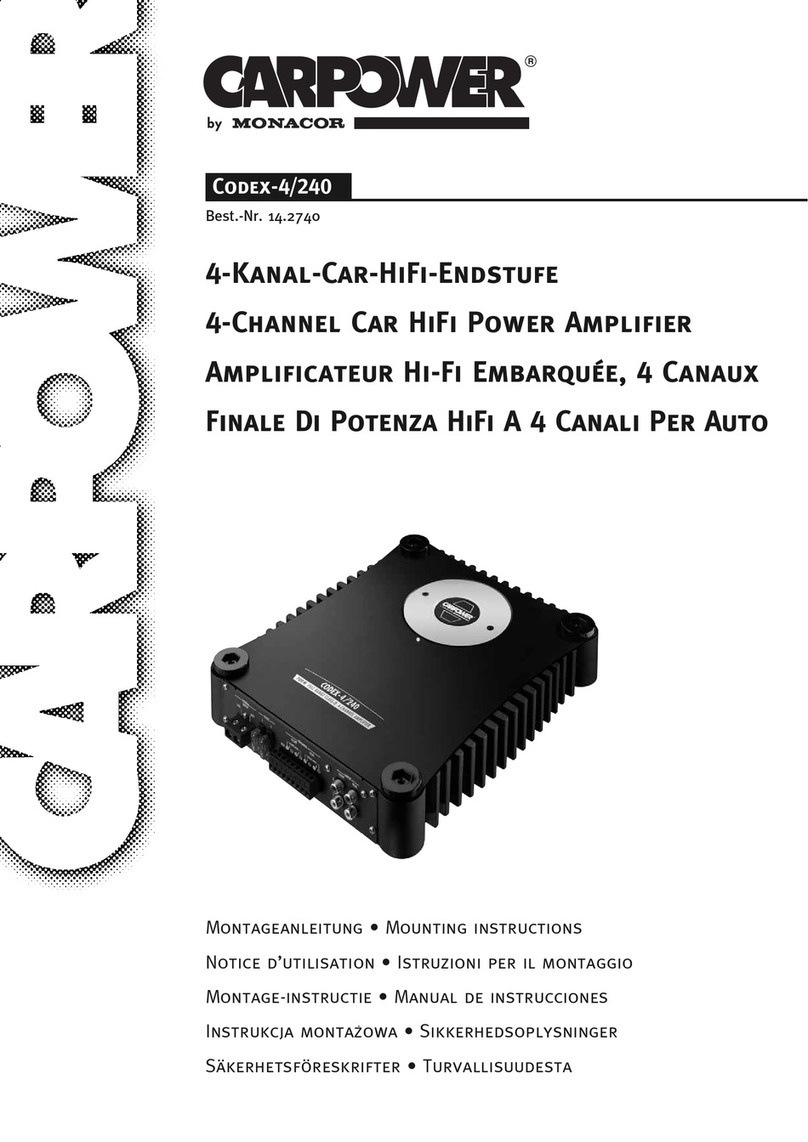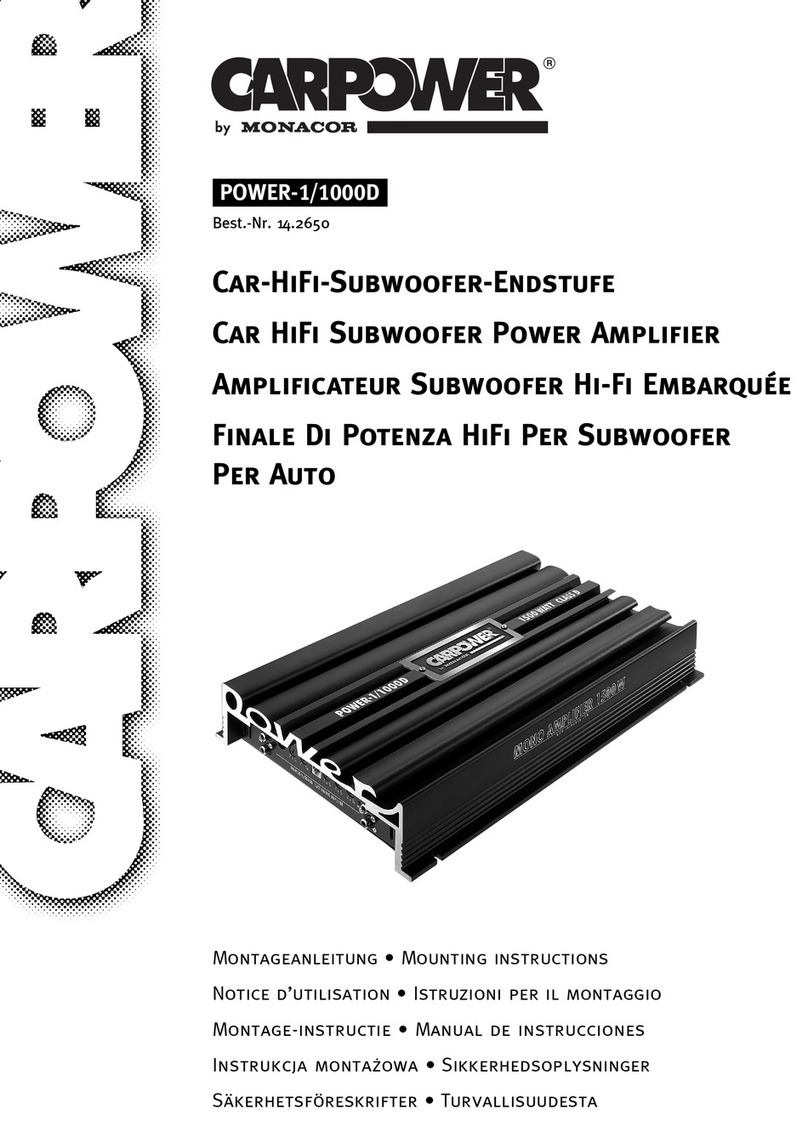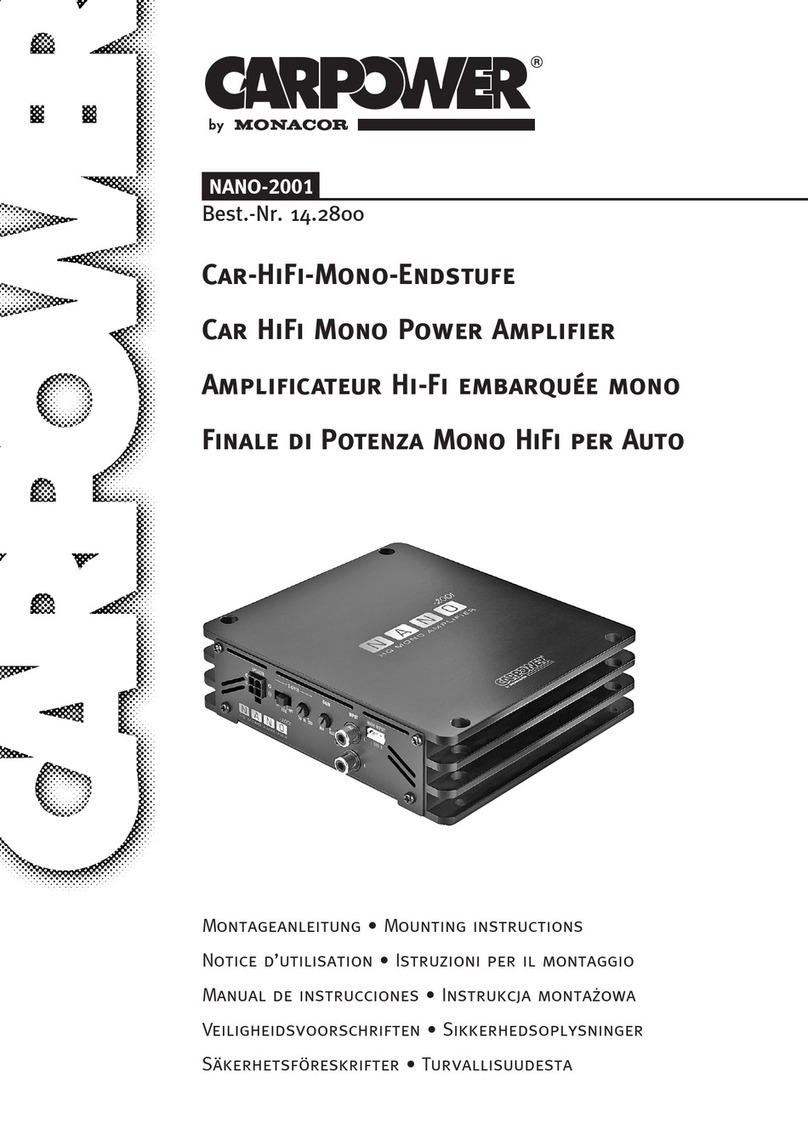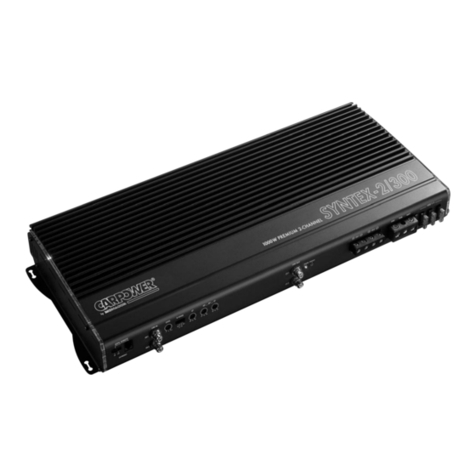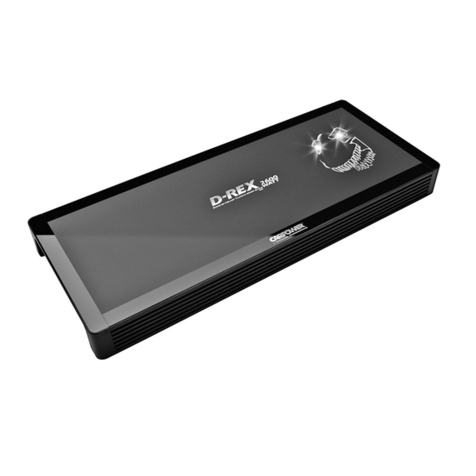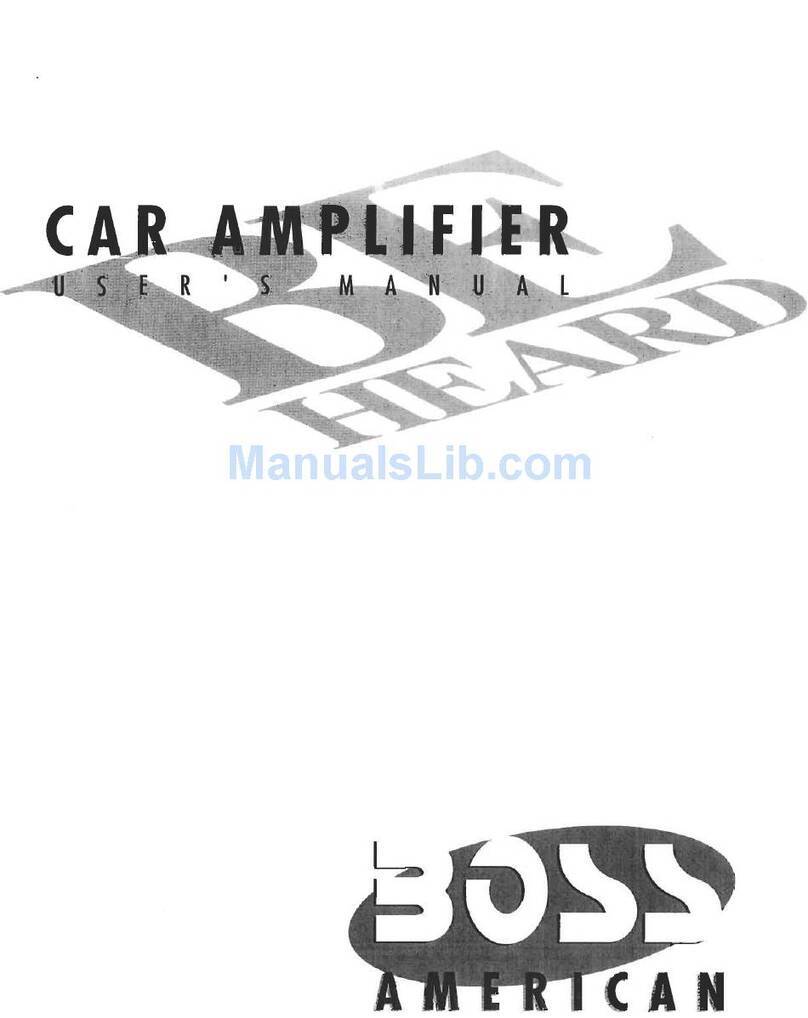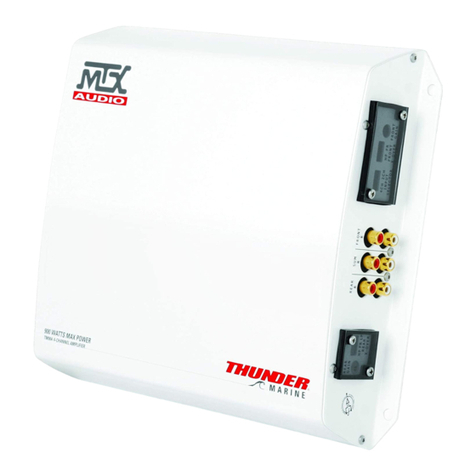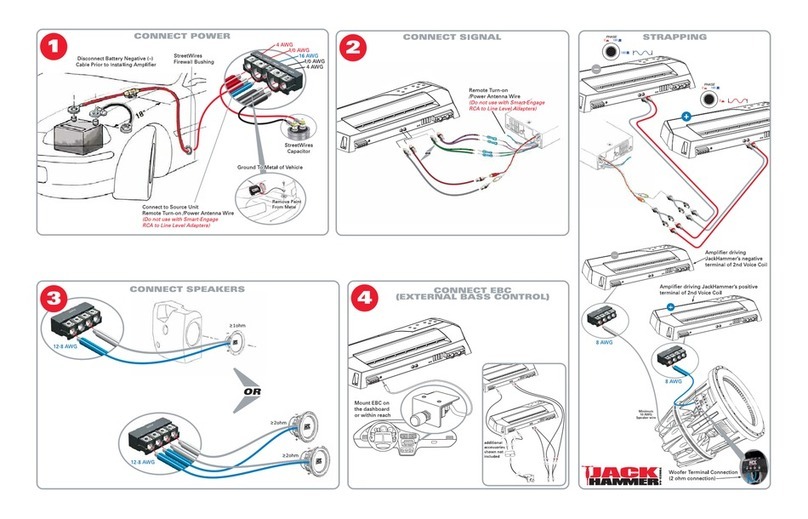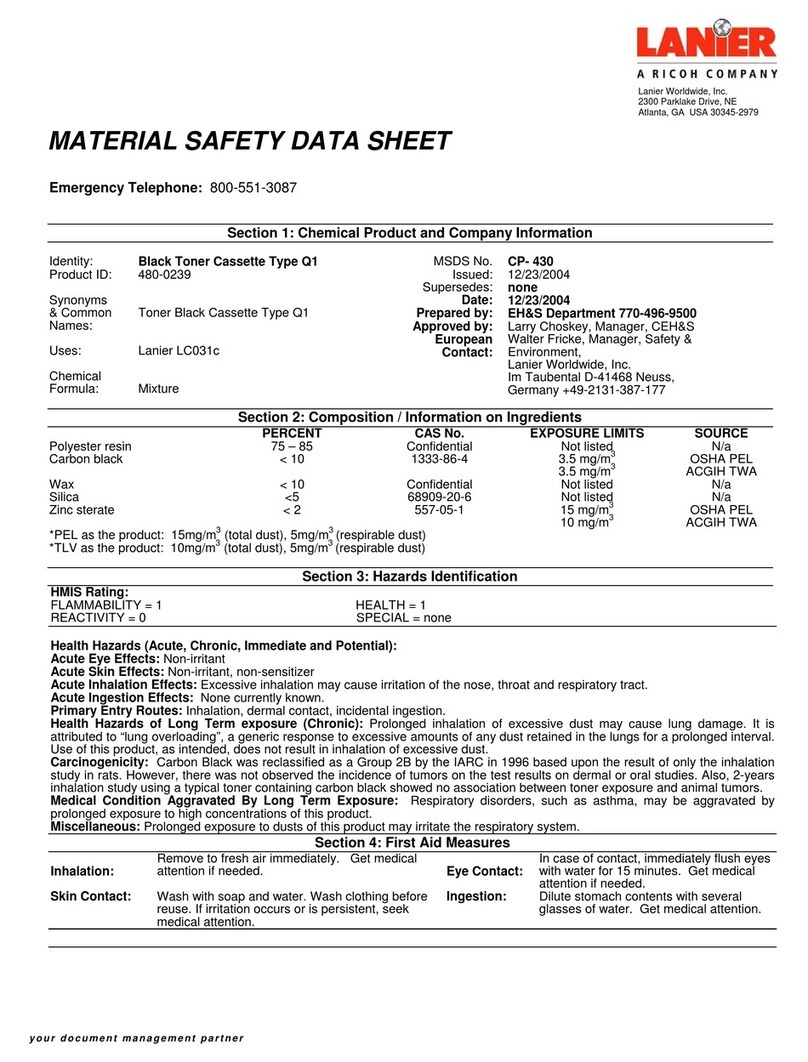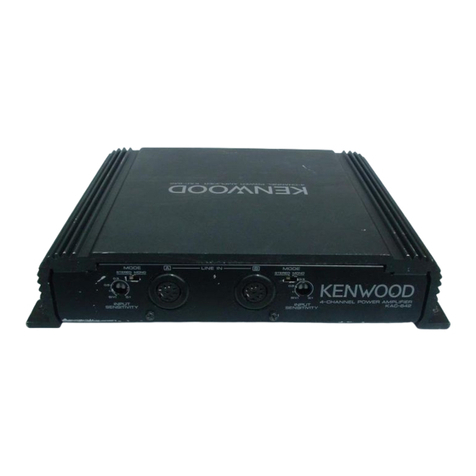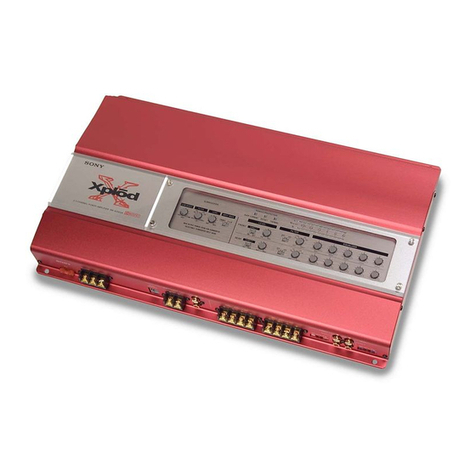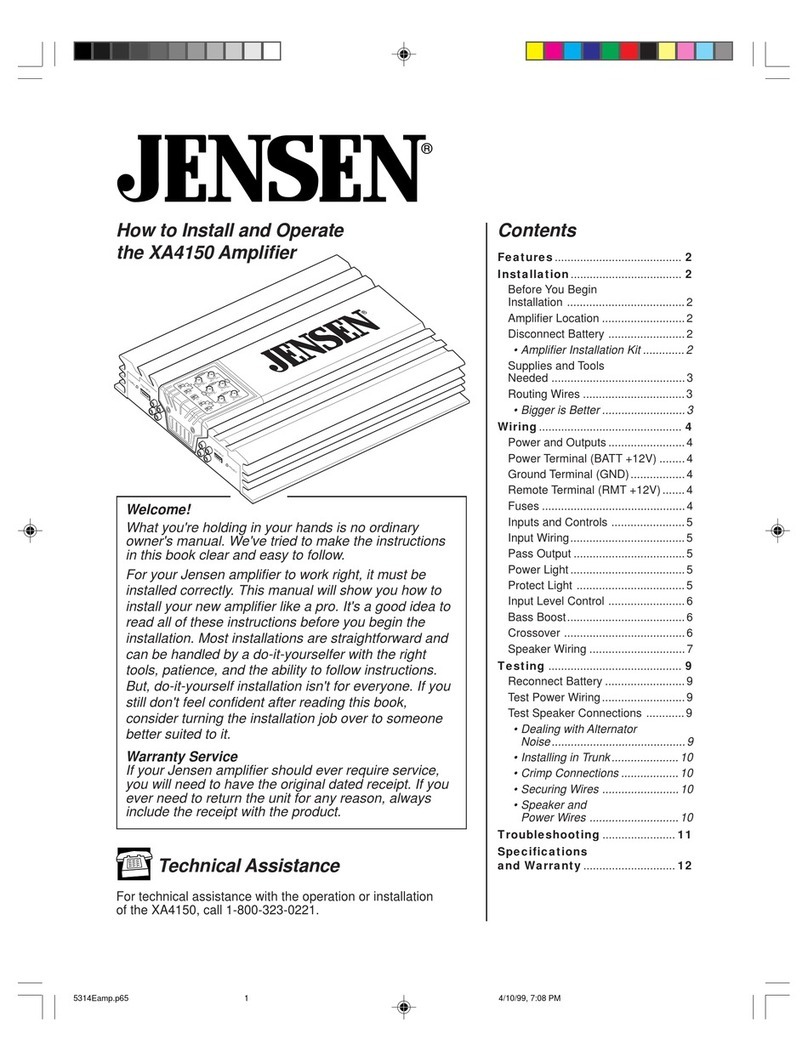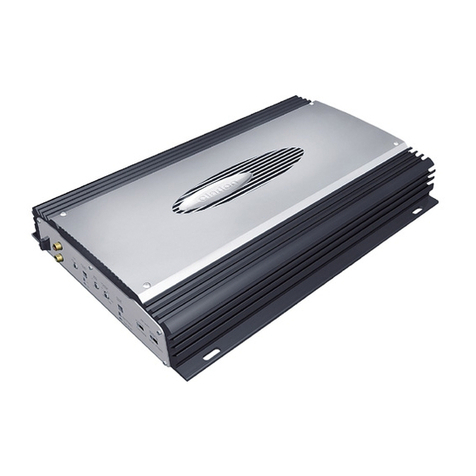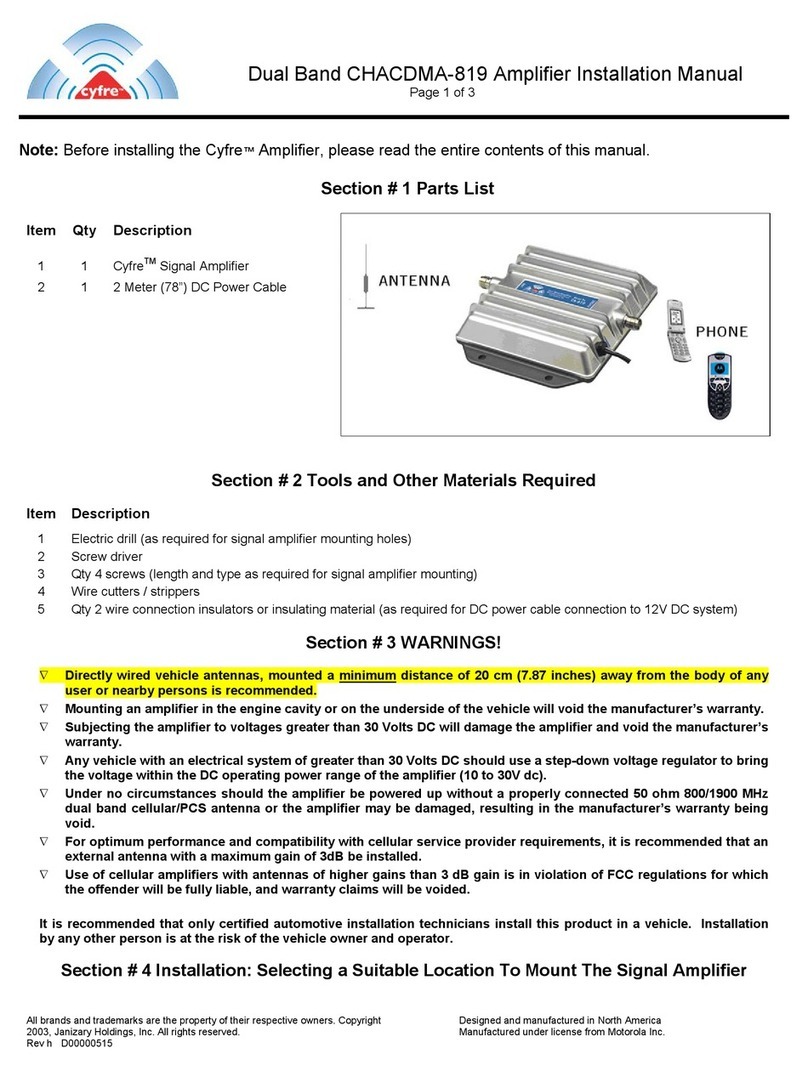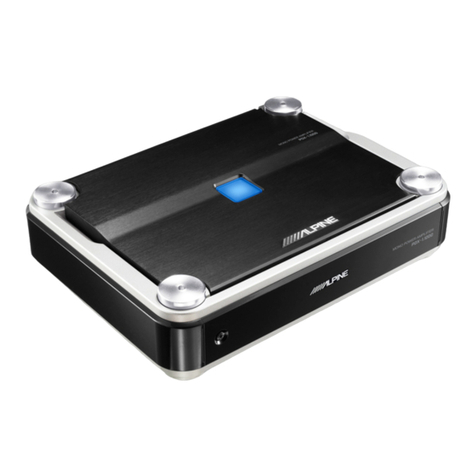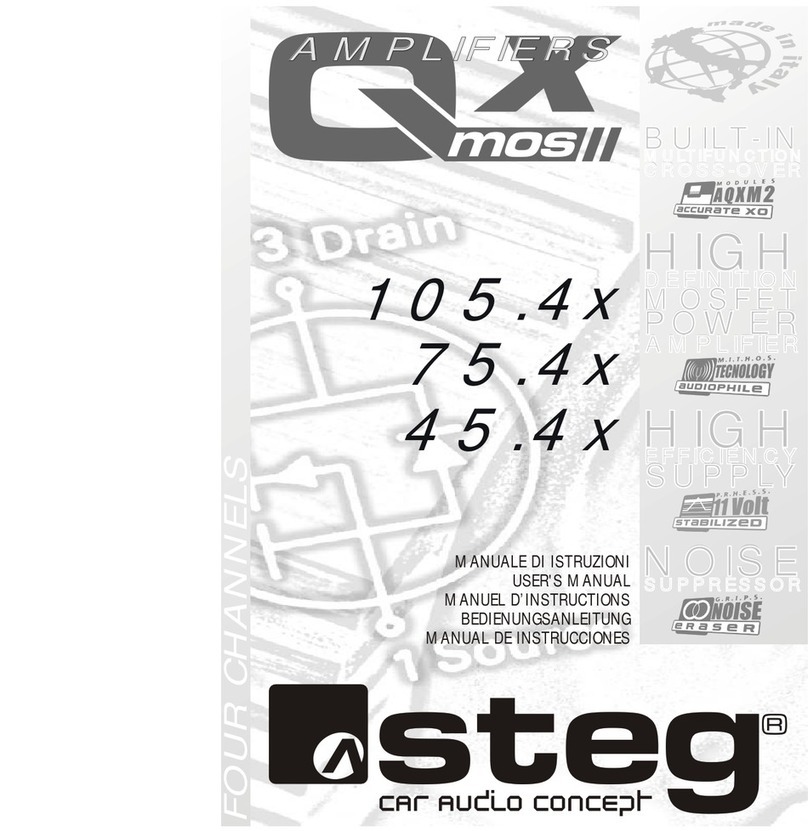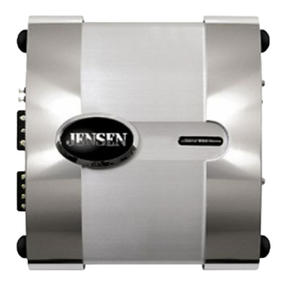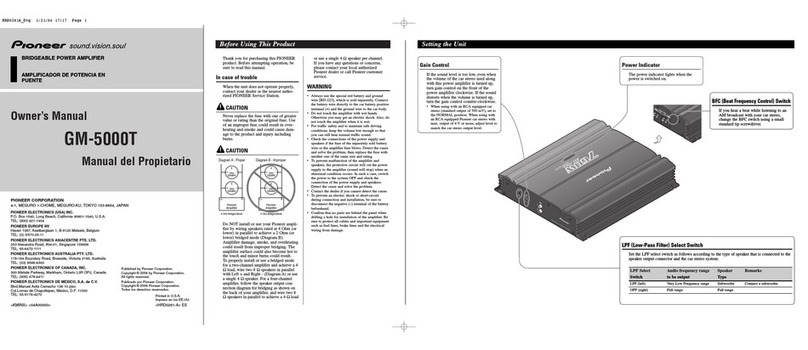Ouvrez le présent livret page 3 de manière à
visualiser les éléments et branchements.
Table des matières
1 Eléments et branchements . . . . . . . . . . . . 8
1.1 Face avant . . . . . . . . . . . . . . . . . . . . . . . . . . 8
1.2 Face arrière . . . . . . . . . . . . . . . . . . . . . . . . . 8
2 Conseils de sécurité . . . . . . . . . . . . . . . . . . 8
3 Attention: Volumes élevés . . . . . . . . . . . . . 8
4 Possibilités d’utilisation . . . . . . . . . . . . . . 9
5 Montage . . . . . . . . . . . . . . . . . . . . . . . . . . . . 9
6 Branchements . . . . . . . . . . . . . . . . . . . . . . . 9
6.1 Alimentation . . . . . . . . . . . . . . . . . . . . . . . . . 9
6.1.1 Borne BATT . . . . . . . . . . . . . . . . . . . . . . . . 9
6.1.2 Borne GROUND . . . . . . . . . . . . . . . . . . . . 9
6.1.3 Borne RMT . . . . . . . . . . . . . . . . . . . . . . . . 9
6.2 Entrées . . . . . . . . . . . . . . . . . . . . . . . . . . . . . 9
6.3 Sorties Ligne . . . . . . . . . . . . . . . . . . . . . . . . 10
6.4 Haut-parleurs . . . . . . . . . . . . . . . . . . . . . . . 10
6.4.1 Mode deux canaux . . . . . . . . . . . . . . . . . 10
6.4.2 Mode bridgé . . . . . . . . . . . . . . . . . . . . . . . 10
6.4.3 Tri mode . . . . . . . . . . . . . . . . . . . . . . . . . . 10
7 Fonctionnement . . . . . . . . . . . . . . . . . . . . 10
7.1 Allumage du filtre et réglage de
la fréquence de coupure . . . . . . . . . . . . . . . 10
7.2 Adaptation des niveaux . . . . . . . . . . . . . . . 10
8 Solution des problèmes . . . . . . . . . . . . . . 11
8.1 Aucune LED ne brille . . . . . . . . . . . . . . . . . 11
8.2 La LED verte POWER brille . . . . . . . . . . . . 11
8.3 La LED rouge PROTECTION brille . . . . . . . 11
9 Caractéristiques techniques . . . . . . . . . . 11
1 Eléments et branchements
1.1 Face avant
1LED PROTECTION: s’allume lorsque le circuit
de protection est activé:
1. lorsqu’une des sorties haut-parleurs (13) est
court-circuitée
2. en cas de surchauffe de l’amplificateur
2Témoin de fonctionnement POWER
3Interrupteur pour le filtre passe-bas
LP: filtre passe-bas allumé
(pour les HP de grave/subwoofer)
FLAT: aucun filtre allumé
(pour le HP large bande)
4Réglage LOWPASS pour la fréquence de
coupure du filtre passe-bas
5Réglage LEVEL pour adapter le niveau d’entrée
6Réglage BASS BOOST pour une augmentation
des graves jusqu’à 18dB
7Sorties Ligne OUTPUT;
le signal de sortie correspond au signal d’entrée
aux prises INPUT (8)
8Entrées Ligne INPUT
1.2 Face arrière
9Branchement masse GROUND
10 Entrée commande RMT pour allumer l’amplifica-
teur via une tension 12V
11 Borne BATT pour la tension d’alimentation +12V
12 Fusibles 4 x 30A;
tout fusible fondu doit être remplacé par un fusi-
ble de même type
13 Branchements haut-parleurs SPEAKERS
2 Conseils de sécurité
Cet amplificateur répond à norme européenne
89/336/CEE relative à la compatibilité électroma-
gnétique.
●Lorsque vous reliez l’amplificateur à la batterie de
la voiture, soyez très prudent; en cas de court-cir-
cuit, des courants très élevés et donc dangereux
circulent. C’est pourquoi avant tout branchement,
n’oubliez pas de dévisser la borne moins de la
batterie.
●L’appareil doit être solidement fixé dans un endroit
mécaniquement stable pour éviter qu’il ne se
dévisse et ne se transforme en projectile dange-
reux.
●Pendant son fonctionnement, l’appareil peut deve-
nir très chaud; il est recommandé de ne pas placer
à proximité d’objets sensibles à la chaleur et de ne
pas le toucher pendant son fonctionnement.
●La chaleur dégagée par l’appareil doit être dis-
sipée par le ventilateur. En aucun cas les orifices
de ventilation du boîtier ne doivent être obturées
par quelque objet que se soit.
●Pour le nettoyer, utilisez un chiffon sec et souple,
en aucun cas de produits chimiques ou d’eau.
●Nous déclinons toute responsabilité en cas de
dommage si l’appareil est utilisé dans un but autre
que celui pour lequel il a été conçu, s’il n’est pas
correctement utilisé, branché ou réparé d’une
manière appropriée.
●Lorsque l’appareil est définitivement retiré du ser-
vice, vous devez le déposer dans une usine de
recyclage adaptée.
3 Attention: Volumes élevés
●Ne réglez jamais le volume trop fort. Des volumes
trop élevés peuvent endommager l’ouïe.
●L’oreille humaine s’habitue à des volumes élevés
et, après un certain temps, ne les perçoit plus de
la même manière. C’est pourquoi nous vous
recommandons de ne pas augmenter le volume
une fois que vous y êtes habitué.
Vi preghiamo di aprire completamente la pagina 3.
Così vedrete sempre gli elementi di comando e i
collegamenti descritti.
Indice
1 Elementi di comando e collegamenti . . . . 8
1.1 Pannello frontale . . . . . . . . . . . . . . . . . . . . . . 8
1.2 Pannello posteriore . . . . . . . . . . . . . . . . . . . . 8
2 Avvertenza di sicurezza . . . . . . . . . . . . . . . 8
3 Attenzione col volume alto . . . . . . . . . . . . 8
4 Possibilità d’impiego . . . . . . . . . . . . . . . . . 9
5 Montaggio . . . . . . . . . . . . . . . . . . . . . . . . . . 9
6 Collegamenti . . . . . . . . . . . . . . . . . . . . . . . . 9
6.1 Alimentazione corrente . . . . . . . . . . . . . . . . . 9
6.1.1 Collegamento BATT . . . . . . . . . . . . . . . . . . 9
6.1.2 Collegamento GROUND . . . . . . . . . . . . . . 9
6.1.3 Collegamento RMT . . . . . . . . . . . . . . . . . . 9
6.2 Ingressi . . . . . . . . . . . . . . . . . . . . . . . . . . . . . 9
6.3 Uscite Line . . . . . . . . . . . . . . . . . . . . . . . . . . 9
6.4 Altoparlanti . . . . . . . . . . . . . . . . . . . . . . . . . 10
6.4.1 Collegamento a 2 canali . . . . . . . . . . . . . 10
6.4.2 Collegamento a ponte . . . . . . . . . . . . . . . 10
6.4.3 Modalità “Tri” . . . . . . . . . . . . . . . . . . . . . . 10
7 Messa in funzione . . . . . . . . . . . . . . . . . . . 10
7.1 Attivare il filtro ed impostare la frequenza
di taglio . . . . . . . . . . . . . . . . . . . . . . . . . . . . 10
7.2 Adattare il livello . . . . . . . . . . . . . . . . . . . . . 10
8 Eliminazione di difetti . . . . . . . . . . . . . . . . 11
8.1 Non si accende nessun LED . . . . . . . . . . . 11
8.2 Il LED verde POWER rimane acceso . . . . . 11
8.3 Il LED rosso PROTECTION rimane acceso 11
9 Dati tecnici . . . . . . . . . . . . . . . . . . . . . . . . . 11
1 Elementi di comando e collegamenti
1.1 Pannello frontale
1Spia PROTECTION si accende con il circuito di
protezione attivato:
1. se una delle uscite per altoparlanti (13) è cor-
tocircuitata
2. se l’amplificatore è surriscaldato
2Spia di funzionamento POWER
3Selettore del passabasso
LP: passabasso attivato
(per woofer/subwoofer)
FLAT: nessun filtro è attivato
(per altoparlanti a larga banda)
4Potenziometro LOWPASS per la frequenza di ta-
glio del passabasso
5Potenziometro LEVEL per l’adattamento del
livello d’ingresso
6Regolatore BASS BOOST per aumentare i bassi
fino a 18 dB
7Uscite Line OUTPUT;
il segnale d’uscita equivale al segnale d’ingresso
alla prese INPUT (8)
8Ingressi Line INPUT
1.2 Pannello posteriore
9Contatto massa GROUND
10 Ingresso di comando RMT per attivare l’amplifi-
catore mediante una tensione di 12V
11 Contatto BATT per il collegamento tensione
+12V
12 Fusibili 4 x 30A;
sostituire un fusibile bruciato solo con uno dello
stesso tipo
14 Contatti SPEAKERS per altoparlanti
2 Avvertenza di sicurezza
Quest’apparecchio corrisponde alla direttiva CE
89/336/CEE sulla compatibilità elettromagnetica.
●Usare particolare cura nel collegamento con la
batteria dell’auto. Nel caso di cortocircuiti ci pos-
sono essere delle correnti molto alte. Prima del
collegamento scollegare il polo negativo della bat-
teria.
●Prevedere un posto solido e montare l’amplifica-
tore con cura per evitare che si possa staccare,
diventando pericoloso in caso di incidente.
●Durante il funzionamento, l’amplificatore può ri-
scaldarsi molto. Non mettere nelle sue vicinanze
oggetti sensibili al calore e non toccare l’amplifica-
tore.
●Dev’essere garantita la libera circolazione dell’
aria per dissipare il calore che viene prodotto
all’interno dell’apparecchio. Non coprire in nessun
modo le fessure di aerazione.
●Per la pulizia usare solo un panno asciutto e mor-
bido; non impiegare in nessun caso prodotti chi-
mici o acqua.
●Nel caso di uso improprio, di comandi sbagliati, di
collegamenti errati o di riparazione scorretta non
si assume nessuna responsabilità per eventuali
danni.
●Se si desidera eliminare l’apparecchio definitiva-
mente, consegnarlo per lo smaltimento ad un’isti-
tuzione locale per il riciclaggio.
3 Attenzione col volume alto
●Non alzare troppo il volume. Il volume troppo alto
può danneggiare l’udito.
●L’orecchio si abitua al volume alto e dopo un certo
periodo non se ne accorge più. Pertanto conviene
non aumentare il volume alto impostato inizial-
mente.
●Mentre si guida l’auto, i segnali di ambulanze ecc.
non devono essere coperti dal volume dell’im-
pianto audio.
8
I
F
B
CH
